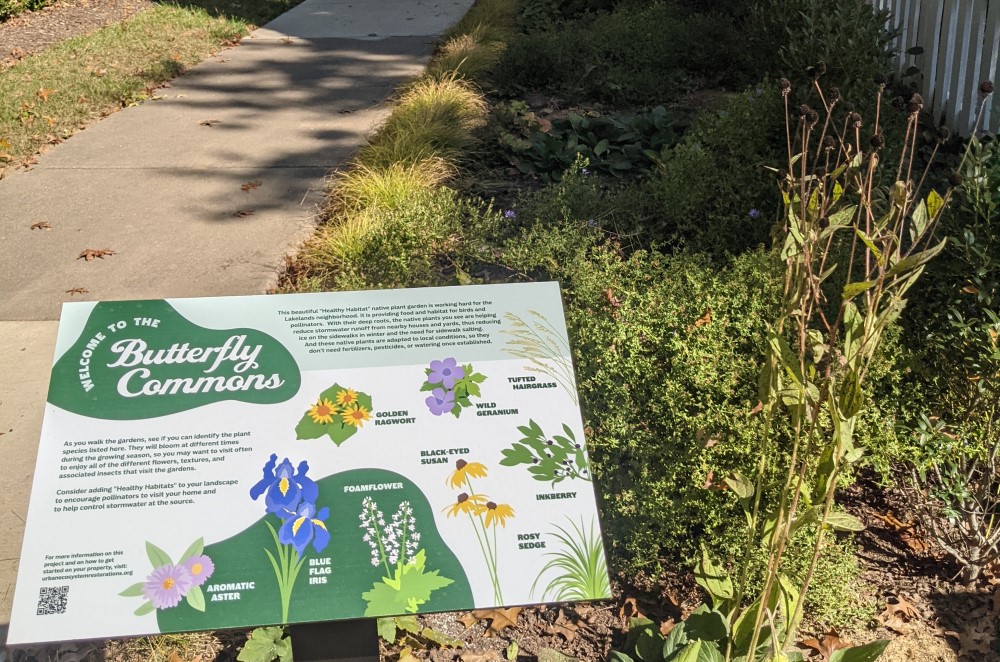A self-professed “nature lover,” Rachel Hopp had noticed fewer birds, butterflies and lightning bugs in her Gaithersburg, Md., neighborhood. But it was an icy sidewalk that ultimately launched her into community-based conservation.
Hopp’s home stands at one end of a semicircle of houses that surround a common green space. When it rained, the tiny strip of lawn in front of each house dumped water onto the sidewalk. In the winter, that water turned into ice, creating dangerous conditions for walking.
The community put down salt, but it didn’t clear the ice effectively, and local leaders knew the chloride was damaging to water quality. Hopp edged her yard with mulch, but the water went through it. She installed a dry well, but it overflowed.
“Is there anything I could do here that would make a difference?” she wondered.
Then she discovered native plants.
Idea Takes Root
Through lectures and workshops by a local botanist, Hopp learned that lawn grasses – which have shallow roots and aren’t native – do very little to absorb stormwater and support wildlife. On the other hand, native grasses and wildflowers soak up rain and provide natural habitat and food for birds and butterflies.
The idea of the Butterfly Commons was born. Hopp mapped out a plan to transform not just her own yard, but the tiny lawn strips all the way around the shared green. Then she brought her idea to the leaders of her community association.
“When I heard about it, I knew we had to do this,” said Bettina Thompson, the vice president of the community’s board of directors.
 Native plants replace turf grass in front of a semicircle of homes, helping to prevent icy sidewalks in the winter.
Native plants replace turf grass in front of a semicircle of homes, helping to prevent icy sidewalks in the winter.From there, the project moved fast. The community partnered with grant funders, native plant experts and landscaping contractors to fill 4,000 square feet with more than 3,000 native plants. And on a beautiful fall day barely a year later, the project leaders gathered with close to 50 guests to celebrate what they had accomplished.
Already, the community has noticed that the young native plants are solving previously intractable problems. They’re keeping water off the sidewalk and reducing the need for salt, while requiring less supplemental water than the turf they replaced.
Once they’ve settled in a little more, the plants won’t need a new blanket of mulch every year. And, judging from the bees still busy in the asters and the birds calling to each other throughout the dedication ceremony, the new native gardens are a big hit with local wildlife too.
Buoyed by the success of the planting, the community has committed to preserve the Butterfly Commons for at least 10 years and to use at least 90 percent native plants in future landscaping projects.
As an environmental attorney, Hopp had faced big challenges in her career, including climate change and acid rain. But tackling a very local problem with a community-based solution provided a deeply satisfying win.
PROBLEM:
Traditional turf grasses
- Don't absorb a lot of water
- Provide few wildlife benefits
- Require a lot of maintenance
SOLUTION:
Native plants
- Help to prevent runoff, ice
- Support birds, pollinators
- Need less maintenance once established
This article was excerpted from “Outdoor America” 2021 issue #4. Want more articles like this? Join the League and get four issues of our award-winning magazine every year.
Join the Izaak Walton League
Top photo: Native asters were still blooming profusely in late October, providing important habitat for native bumblebees. Photo credits: Janette Rosenbaum.